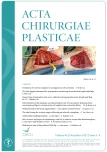Editorial
Published in the journal:
ACTA CHIRURGIAE PLASTICAE, 64, 3-4, 2022, pp. 109
Category:
Editorial
Dear readers,
cancers of the oral cavity and oropharynx are among the ten malignancies with the most frequent occurrence in the human population (about 15% of the total number of malignant tumors). Worldwide, approximately 500,000 new cases of the disease occur each year. At the same time, only about one third of patients survive 5 years after diagnosis. The percentage share of these tumors in the total number of malignancies in the Czech Republic is around 2% (US 3%, Southeast Asian countries 35–40%).
Currently, the incidence of oropharyngeal malignancies is increasing in the younger generation (often occurring cancers in the fourth and third decades of life), the percentage of malignancies in women is increasing, as well as the number of distant metastases from extraoral primary tumors. Currently, the malignancies of the oropharynx and oral cavity have also duplicity or multiplicity of occurrence.
In 90% of cases, they are malignant epithelial tumors, most often squamous cell (epidermoid) carcinoma. The remaining 10% include adenoid cystic carcinoma, mucoepidermoid and other salivary gland adenocarcinomas, and then malignant lymphomas, rarely sarcomas. On the skin of the face, we most often encounter basal cell and squamous cell carcinomas, melanomas, only exceptionally with some other rare malignancies such as Merkel cell carcinoma. Conversely, malignant mesenchymal tumors (with the exception of hematological malignancies) are significantly rarer in the oropharyngeal region.
Histological verification of squamous cell carcinoma of the oral cavity and oropharynx is usually not difficult. However, recognizing the early stages of invasion can be problematic for the pathologist, similarly to demonstrating bone invasion and nodal micrometastases.
In the last few years, a number of clinical and pathomorphological criteria have been established, which are now commonly used to determine histopathological staging and are of key importance for postoperative treatment and prognosis estimation of cancers of the oral cavity and oropharynx (tumor location and volume, histopathological grading, invasive tumor growth, histological type of squamous cell carcinoma, positivity of resected margins, presence of locoregional and distant metastases, bone invasion of the tumor into the orofacial skeleton)
The prognosis of a malignant tumor of the oral cavity and oropharynx is mainly determined by the degree of invasiveness of the primary tumor and the extent of metastatic involvement of regional and distant nodes. The prognosis of malignancies of the oral cavity and oropharynx depends primarily on early diagnosis, which is significantly influenced by the clinical experience and oncological awareness of doctors and the lay population.
The main goal of the surgeon is to achieve microscopically negative margins. The destructive phase should not be limited by concerns about whether and how the defect can be reconstructed. When planning a surgical procedure, it is therefore necessary to take into account several points of view and find a reasonable compromise between them with an emphasis on preserving mastication, phonation, the act of swallowing and aesthetics. In modern head and neck oncology, it represents the radical removal of the tumor followed by reconstruction of the associated vessel.
I believe that today's issue of Acta chirurgiae plasticae will be a useful contribution to our knowledge of head and neck oncology and further evidence of the vitality of this journal.
Assoc. Prof. Richard Pink, MD, DMD, PhD
Štítky
Chirurgia plastická Ortopédia Popáleninová medicína TraumatológiaČlánok vyšiel v časopise
Acta chirurgiae plasticae

2022 Číslo 3-4
- Metamizol jako analgetikum první volby: kdy, pro koho, jak a proč?
- Fixní kombinace paracetamol/kodein nabízí synergické analgetické účinky
- Antidepresivní efekt kombinovaného analgetika tramadolu s paracetamolem
- Kombinace metamizol/paracetamol v léčbě pooperační bolesti u zákroků v rámci jednodenní chirurgie
- Kombinace paracetamolu s kodeinem snižuje pooperační bolest i potřebu záchranné medikace
Najčítanejšie v tomto čísle
- Mini-invasive technique of sclerotherapy with talc in chronic seroma after abdominoplasty – a case report and literature review
- Multifarious uses of the pedicled SCIP flap – a case series
- 3D color doppler ultrasound for postoperative monitoring of vascularized lymph node flaps
- Evaluation of resection margins in oral squamous cell carcinoma

